1967 Thunderbirds F-100D Super Sabre – Italeri 1/72
This article is part of a series:
Thunderbirds F-100D Super Sabre
THE F-100D ERA
on May 25, 1953, the Air Force's official air demonstration team, designated the 3600th Air Demonstration Unit, was activated at Luke Air Force Base, Ariz. The unit adopted the name “Thunderbirds,” influenced in part by the strong Native American culture and folklore from the southwestern United States where Luke Air Force Base is located.
The team flew and maintained the F-84G Thunderjet. The straight-wing configuration of the F-84G was considered well suited for aerobatic and demonstration maneuvers, though the aircraft could not exceed the speed of sound.
Always trying to display the most advanced fighters of the age, the swept-wing F-84F Thunderstreak became the team's new aircraft in 1955.
After one season in the F-84F Thunderstreak, the Thunderbirds traded aircraft again and became the world's first supersonic aerial demonstration team as it transitioned to the F-100C Super Sabre in 1956. That same year, to simplify logistics and maintenance for the aircraft, the Thunderbirds moved to Nellis AFB, Nev.
Nearly forgotten, the F-105B Thunderchief performed only six shows between April 26 and May 9, 1964. Following an unfortunate accident in the F-105, the team transitioned back to the Super Sabre following the incident and the F-100 remained with the team for nearly 13 years.
The Thunderbirds started the 1969 training season still in the F-100Ds, but in the spring of 1969, received the first of the new McDonnell Douglas F-4E Phantom IIs and began the team's conversion.
The plane I've built is the (‘D' version) ‘SIX', in the 1967 season.
PAINTING
As I've got the kit already built (oob) from a friend, I just had to paint it.
Being a fan of this plane since kid when I read “Michel Vaillant – Concerto pour Pilotes” book by Jean Graton, and as I planned to build all the Thunderbirds planes, the version was chosen.
Note: Among other small differences, like the probes, C version planes had serial number on the tail and a less complex scheme while D version got the team number (in place of the serial number) and a stylized bird on the underside.
There was only a small detail worth mention: there are no decals for the F-100 Thunderbird in 1/72… “Well, I guess I'll have to do some masking” ? And so it was. Apart from the national and squadron insignias, US lettering and flags (home printed), all was painted.
Following an extensive mask and painting job, here are some pictures of the journey and the final result.
As someone would say “painted, not decaled”











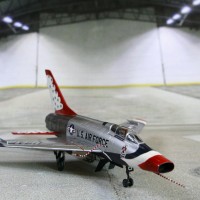
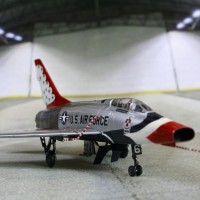
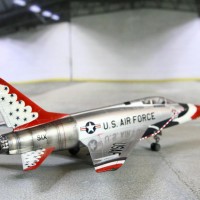




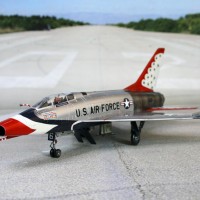


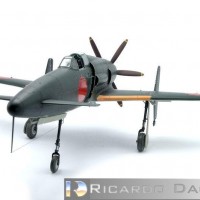



Nice work. I always thought the F-100 was the best plane the 'Birds flew.
Ummm... I think Bob Mariano kept Six flying (as in crew chief). A minor typo there (something i deal with all the bloody time).
Thks Tom. My mistake... I misunderstood this last photo. But yes, I've checked my references and He was the crew chief for the Six.
Well, it's done and his name is in the cockpit as in the real six in the museum...
1 attached image. Click to enlarge.
If it wasn't for the crew chiefs, the pilots would be pedestrians.
And it's right - crew chief on the right side of the canopy, pilot on the left.
An absolutely fantastic build ! Great job.
Thks Robert
simply stunning
Thks Bob
Always been my favorite Thunderbird's version - it just "looks the part" - beautiful work, sir; you've done her proud.
Thks Craig! Always kind words...
Yours very nice too
wonderful little bird, congrats. Great job painting those markings, Manuel. The original kit from ESCI had a Thunderbird version, actually, but the decals -although nicely printed- were very brittle, thick and not responding to softing and setting solutions. I have them somewhere in my stash, never dared to use them.
May I mention two minor errors: The canopy frame behind the seat is not existent on real planes and the late (ex F-102) afterburner should be changed to the original type. Both things still can be fixed.
Actually, the F-100Ds of the T-Birds were the first ones to get the F-102 nozzles, so yeah, it's right.
I always thought the modification began in the early 1970s, after retiring the Hun from the Team
Well, here we have a D (at least it seems) with the "old" exaust
1 attached image. Click to enlarge.
that´s the 'new' exhaust. Is this a restored museum example using an ex-ANG airframe?
Wolfgang @wolf21379 , here is the info I have.
But if this is the new exaust, then my build would be ok. Or not?
In the same site, for the same plane is stated that it "was restored by Thunderbird maintenance personnel to its original appearance as a team aircraft." So I trusted...
2 attached images. Click to enlarge.
Thks for your comments Wolfgang and Tom! I appreciate and will try to correct.
Regarding the canopy frame it's molded so I think I went along at masking time and didn't even thought about.
For the afterburner, as I told, I received the kit already built and don't have the other part... maybe will find one in aftermarket.
Thanks for pointing that out!
Wow - that's one bang-up paint job! Well done. Makes a beautiful T-bird. I think the Hun was also my fav as a T-bird.
Thks Greg!
Indeed F-100 rocks!
And the Hun is already in my stash
F-100s are one of the coolest planes around, and your paint & finish is great!
Thks
Excellent build and fine photography...my congratulations.
Thks! Thought she deserved some nice pics
Amazing! What paint job.
Thks Mike!
Showbirds are definitely a challenge, but it looks like you pulled that one off. Excellent work.
Thks Dan, it was quite a challenge paint it all, but turned out quite nice
Hello Manuel,
Besides modeler, you are also a great artist. Splendid airbrush job on this famous aircraft.
Also thanking you for the small article, accompanying the model.
Regards, Dirk
Hi Dirk,
I really do appreciate your very kind words, thanks so much.
I like to build planes with a story or, at least, know their history.
If you like, and have some spare time, I invite you to see some of my other builds (like the Horsa or the Mosquito, among others) which have also some history in their articles.
Regards,
Manuel